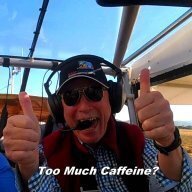Kyle:
I can't speak for others, but the first few times I flew into "other airfields" I was also apprehensive. I had to do a lot of position plotting in my head about where to approach the airfield from to enter the circuit etc and that added a bit to my stress levels.
It does get easier with practice. It never gets as relaxed as driving a car, but as you get more confidence with your navigation the workload eases up and you start to get ahead of the airplane rather than just keeping up.
The other thing that helps is a familiarity with the airplane you're flying. If you try to fly the one plane as much as possible, that will settle the nerves a bit as your muscle memory will help with the control positions etc so there's less to focus on just to fly the plane. BUT, that can be a double edged sword if you are then forced to fly an unfamiliar airplane.
The rotor off Mt Brisbane at Watts Bridge can be a little unsettling if the winds are from the SE at or above 25Kt and you can't afford to be complacent in the approach. That said, I have been flying out of Watts Bridge for some time and have not yet encountered dangerous conditions there. I doubt your instructor would let you fly there if the conditions were dangerous, It is good for you to remember about rotor on the lee side of hills/mountains and be ready to take quick action if things start to look dodgy.
WRT to height over the range, keep an eye on your height in that area too. On the south side of the Woodford valley, the overhead steps vary from 3500 on the east side to 4500 somewhere in the middle so you can't let any updraft carry you up too high. North of the Woodford valley is a different matter and there is more room there.
No, as regards to navigation in the "local" area. When I first started flying, my "local" area was around Caboolture, up to Noosa, and to the west to the Glass House mountains. After a few flights, I could navigate in that area without reference to charts and always know where I was. Now, my "local" area extends to the west to about Chinchilla, North to Rockhampton, and south to Inverell. I can navigate those areas without a chart and pretty well know where I am at any given time. Just as the airplane gets you further faster, it also expands the area that you'll feel comfortable with navigating by landmarks. As you get to know your neighborhood roads by car, you'll get to know your neighborhood landmarks navigating by air.
WRT Turbulence. LOL, I still don't like flying in the bumps and avoid them when I can, by going higher, but they don't make me weak at the knees like they used to. It does get better, especially when you finally realise that the turbulence is not going to rip the wings off or turn the airplane upside down. That is to say, those things could happen, but I seriously doubt you would choose to go up in the kind of conditions that would rip the wings off the plane.
And finally (yeah I know this was a long rant) if you can afford to buy a plane now or in the future, there are a lot of advantages that you can't get renting. For a start, when you're renting, you have to book ahead. Then the weather goes south and that's another flight missed. Also, when the weather is looking good and you want to book a plane ... everyone else does too. In addition, there are a lot of overnight flying events and trying to convince a flying scholl to let you have their airplane for 24-48 hours for 5-6 hours hobbs time is a big ask. AND, those overnight fly ins usually will take you further and give you more nav experience. But most fun of all with your own plane you can join a touring group and go to amazing places, Since we've been in our touring group (Puk Airlines) we've been to Ayers Rock, Lake Eyre, Coober Pedy, Lighning Ridge, Longreach, Carnarvon Gorge, Great Keppel, Broken Hill and a lot of others. And more to come.
Good luck with your flying. Fair skies and tailwinds.











